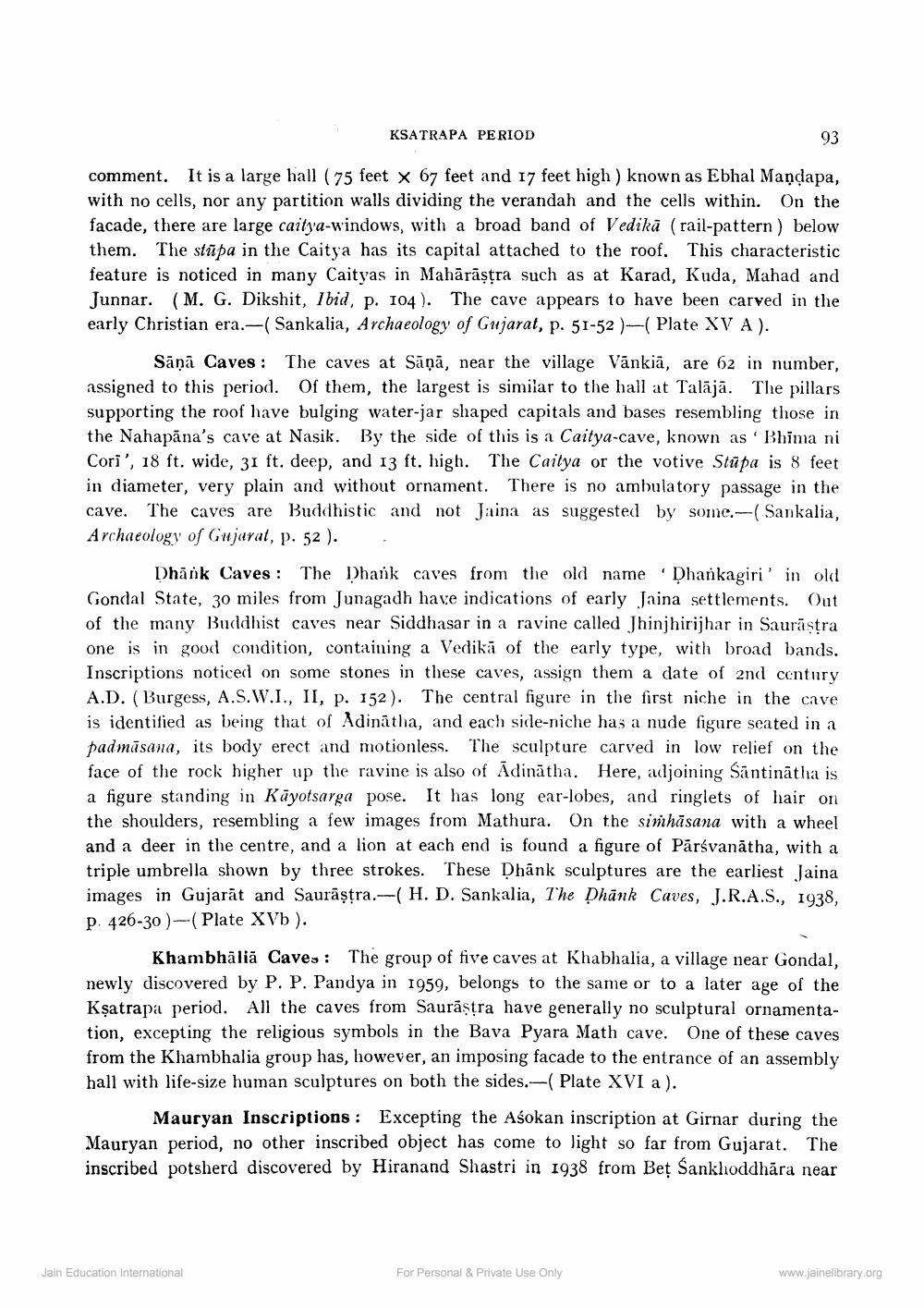________________
KSATRAPA PERIOD
93
comment. It is a large hall ( 75 feet x 67 feet and 17 feet high ) known as Ebhal Mandapa, with no cells, nor any partition walls dividing the verandah and the cells within. On the facade, there are large caitya-windows, with a broad band of Vedikā (rail-pattern) below them. The stūpa in the Caitya has its capital attached to the roof. This characteristic feature is noticed in many Caityas in Mahārāstra such as at Karad, Kuda, Mahad and Junnar. (M. G. Dikshit, Ibid, p. 104). The cave appears to have been carved in the early Christian era.- Sankalia, Archaeology of Gujarat, p. 51-52 )–(Plate XV A).
Sāņā Caves : The caves at Sāņā, near the village Vānkiā, are 62 in number, assigned to this period. Of them, the largest is similar to the hall at Talājā. The pillars supporting the roof have bulging water-jar shaped capitals and bases resembling those in the Nahapāna's cave at Nasik. By the side of this is a Caitya-cave, known as Bhima ni Cori', 18 ft. wide, 31 ft. deep, and 13 ft. high. The Caitya or the votive Stūpa is 8 feet in diameter, very plain and without ornament. There is no ambulatory passage in the cave. The caves are Buddhistic and not Jaina as suggested by some.---( Sankalia, Archaeology of Gujarat, p. 52 ).
Dhark Caves : The Dhark caves from the old name Dhankagiri' in old Gondal State, 30 miles from Junagadh have indications of early Jaina settlements. Out of the many Buddhist caves near Siddhasar in a ravine called Jhinjhirijhar in Saurāstra one is in good condition, containing a Vedikā of the early type, with broad bands. Inscriptions noticed on some stones in these caves, assign them a date of 2nd century A.D. ( Burgess, A.S.W.I., II, p. 152). The central figure in the first niche in the cave is identified as being that of Adinātha, and each side-niche has a nude figure seated in a padmāsana, its body erect and motionless. The sculpture carved in low relief on the face of the rock higher up the ravine is also of Adinātha. Here, adjoining Santinātha is a figure standing in Kāyotsarga pose. It has long ear-lobes, and ringlets of hair on the shoulders, resembling a few images from Mathura. On the simhāsana with a wheel and a deer in the centre, and a lion at each end is found a figure of Pārsvanātha, with a triple umbrella shown by three strokes. These Dhānk sculptures are the earliest Jaina images in Gujarāt and Saurāṣtra.--( H. D. Sankalia, The Dhānk Caves, J.R.A.S., 1938, P. 426-30 )-(Plate XVb ).
Khambhāliã Caves : The group of five caves at Khabhalia, a village near Gondal, newly discovered by P. P. Pandya in 1959, belongs to the same or to a later age of the Kşatrapa period. All the caves from Saurāṣtra have generally no sculptural ornamentation, excepting the religious symbols in the Bava Pyara Math cave. One of these caves from the Khambhalia group has, however, an imposing facade to the entrance of an assembly hall with life-size human sculptures on both the sides.- Plate XVI a).
Mauryan Inscriptions : Excepting the Asokan inscription at Girnar during the Mauryan period, no other inscribed object has come to light so far from Gujarat. The inscribed potsherd discovered by Hiranand Shastri in 1938 from Bet Sankhoddhāra near
Jain Education Intemational
For Personal & Private Use Only
www.jainelibrary.org




